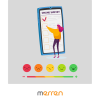How many market researchers does it take to change a light bulb? 30. One to change the bulb, and 29 to get its significance. Oh, you think it’s a bad joke. I agree. But you and I make for a sample size of two and that is clearly not enough to make the conclusion.
A sample size determination is no joke. In fact, this is perhaps one of the more complex decisions to make in a survey research study. It impacts how assured you would be in your ultimate findings. Plus a good sample size calculation can help you confidently pick from close choices. Surely, it also impacts how much you will end up spending.
So, how do you select an ideal size of the sample for your study if you are not an accomplished statistician. Here are the four ways:
What is a homogenous group?
If you are looking for a safe, can’t-go-wrong type thumb rule, pick an appropriate sample size of 400 (385 to be precise) per homogenous group. What is a homogenous group? It is a cluster of members whose behavior is assumed to be similar to the other member of the group and different from non-members of the group. Typical examples of homogenous groups are males/ females, young/ old, smartphone users/non-user determine the target population.
So, is it as simple as that? Just take 400 of each number of respondents that form your customer base and you are ready to launch your study? Well, not really. Do that and your research is probably (almost certainly) going to go over-budget quickly.
The other end of this spectrum is the magic number of 30. You can choose a sample size of 30 (a little more, in case you provision for loss to data cleaning) for each of your homogenous group. Why 30 you ask? Without getting into discussion around Central Limit Theorem or Normal curves, the easiest explanation is that if you pull 30 samples from a larger population randomly, these samples should start to mimic the population. And that is what you want- Your sample should be a replica of the entire population you want to study. Of course, the more samples you pick, the better a replica it would be.
So why is this not the end of the discussion? Why not pick 30 per group every time? Well, because it makes a two major assumptions- one, the homogenous groups are truly homogeneous, and two, the randomization is truly random. Neither of these assumptions work well in real-life scenarios.

Borrow from the wisdom of the experts
- So, if not 30 or 400, then what? The next easiest route is to borrow from the wisdom of the experts and use some thumb rules. The table below gives some sample size thumb rules that are used by practitioners often.
| Study Type | Minimum Size | Typical Size |
| Name Test | 100 per name tested | 200-300 per name and respondent category (for example, males vs females) |
| Package tests | 100 per package tested | 200-300 per package and respondent category |
| Ad testing | 150 per ad | 200-300 per ad |
| Concept/ Product test | 200 | 200-300 per concept/ product and respondent category |
| New product-market-penetration test | 200 | 300-500 |
| Market understanding | 500 | 500-1500 |
| Pricing study (Simple Monadic) | 60 per price level | 100-150 per price level |
| Pricing study (Van Westendorp) | 200 | 100-150 per respondent category |
| Multiple Linear Regression [Green (1991)] | 50+ 8 * no. of predictors | 20-50 per predictor |
| Linear Regression for testing importance of predictors[Green (1991)] | 104 + no. of predictors | 20-50 per predictor |
Adapted from Hyman, Michael & Sierra, Jeremy. (2010). Selecting a sample size for your customer survey. NMSU Business Outlook.
But do remember- these are just thumb rules and should work in most cases you would encounter. But they will not work in all scenarios so handle with care.
How to calculate the sample size for your survey?
Use online sample size calculators
Use online sample size calculators like the one here. It will require you to understand concepts like margin of error, confidence level and response distribution, but the site does a good job of explaining the basics.
Calculate the sample size yourself
If you are feeling adventurous and want to calculate the sample size yourself, why not? If your target group of people has a large population size, you can use the following formula:
n = (zs/e)2
where:
n is the sample size
z is the confidence interval for the desired level of confidence (you can find z tables here)
s = estimated standard deviation
e = desired margin of error
Irrespective of what method you use, most times the right sample size selection boils down to a trade-off between expected precision and cost to attain it. Getting the perfect sample size is critical to confident decision making. The four methods mentioned above should guide you in choosing the one that can augment your market research.
Want to achieve significant results from your survey? Merren provides a free 14 day trial session where you can easily hear from your audience. Our messenger based surveys are very simple to create, execute and analyze across organizations. Check it out today!





